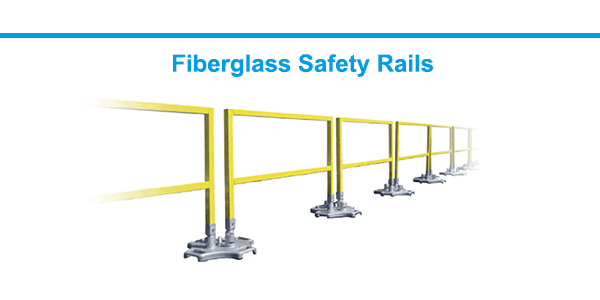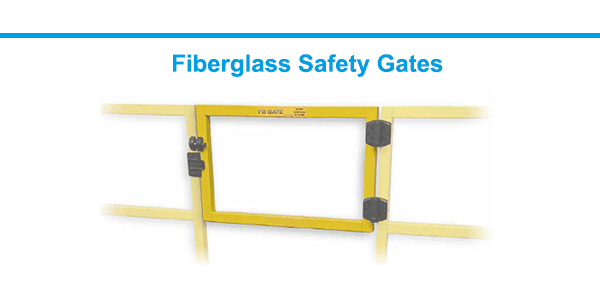It's common for the rooftops of industrial facilities to hold mechanical equipment and technological systems in an effort to take full advantage of the available space. The rooftop and the equipment on it need to be regularly maintained, and occasionally repaired or replaced. Whenever work is to be done on the rooftop, you’re responsible for ensuring that the rooftop meets OSHA requirements for fall protection, such as having an OSHA compliant guardrail system in place. Although metal guardrails are the most common choice, a fiberglass guardrail system offers distinct advantages in certain situations.
Fall protection isn't always straightforward when you're talking about an industrial rooftop. The size, slope, and material covering the roof are all unique. Every facility in every industry has a different type of setup for rooftop mechanicals like HVAC, refrigeration, and filtration systems. Increasingly, other technological systems are also housed on the roof, which presents unique challenges with regards to equipment function. Fiberglass fall protection guardrails provide OSHA-compliant fall protection as well as other key benefits including:
Won't Interfere with Sensitive Technology
Since fiberglass fall protection is not conductive or magnetic, it's the ideal material to use when protecting rooftop cell sites, signal-boosting antennas, and other technology that uses RF signals. Unlike metal railings that interfere with RF signals, fiberglass guardrails are RF-transparent and don't affect the operation of this type of communication equipment.
Help Eliminate Risk of Shock or Electrocution
Working on a rooftop can be risky for workers, especially in high-voltage situations such as making equipment repairs or during equipment installations. Inclement weather and lightning strikes are also a concern for rooftop workers. Since fiberglass railings are non-conductive, workers can safely use them without additional risk.
Fiberglass Is Both UV and Fire Resistant
When it comes to long-lasting, durable materials, fiberglass is right up near the top of the list for guardrail systems. Made of polyester, they are fire resistant, which means that they inhibit the spread of heat and flames in a fire. They're also coated with a material that minimizes the effects of UV light on the material. Both features make fiberglass ideal for any industrial rooftop application.
Lightweight, Flexible, and Versatile
Unlike bulky, heavy steel guardrails, a fiberglass guardrail system is relatively lightweight. This allows them to be used easily as portable railings that can be configured in whatever way works for you in just moments. And because of their non-penetrating design they don't penetrate the roof's surface, you never have to worry about damage to the roof.
Can Be Used in a Variety of Climates
When the sun beats down on a traditional metal guardrail, it could get hot enough to burn a worker who grasps it. And in cold weather, steel guardrails can become painfully cold to touch. The low heat-conductivity of their material makes fiberglass guardrails resist extremes of temperature in much the same way they resist electrical currents and fire. Whether the weather is hot and sunny or wet and cool, fiberglass railings are comfortable to grip. In addition, fiberglass railings are naturally non-slip so workers can keep a firm grip without slipping.
The truth is, fiberglass is a good choice for guardrails for rooftop fall protection systems as well as inside your facility for all the reasons noted above. Perhaps the only real drawback is that the initial cost of a fiberglass guardrail system is higher than that of a traditional metal guardrail. But, when you take into account that they're cheaper to ship, require less maintenance, and have a long life, you’ll likely find that it's worth the investment.
Per OSHA 1910.28, Duty to Provide Fall Protection and Falling Object Protection, you must ensure workers are protected from falls at heights of 4 feet or more near an unprotected edge. So make sure you're using OSHA-compliant rooftop fall protection systems such as a metal or fiberglass guardrail system. Rooftop fall hazards that need to be protected include the perimeter of the roof, rooftop hatches, skylights, uneven surfaces, holes more than 2" in diameter, and any other identified trip or fall hazard.
In order to provide adequate fall protection on your industrial rooftop, it's important that your rooftop fall protection systems meet the standards in OSHA 1910.29. Regardless of where you're installing on a rooftop an OSHA compliant guardrail must:
Measure 42" from the walking surface, give or take 3"
Withstand 200 lbs. of downward force without failure or deflecting below 39" from the walking surface
Handle, without failure, a force of 150 lbs. of downward or outward force
There are no OSHA requirements that state what material safety railings must be made of. OSHA 1910.29 does specify, however, that the material used to make guardrails must be smooth and free of snags that could scratch, cut, or catch a person's skin or clothing. Both metal and fiberglass guardrails can meet these criteria (or fail to meet them, if damaged or poorly maintained). It's up to you to decide which material is best suited to your building and your budget. However, fiberglass is becoming more popular than ever for rooftop guardrails, and you may see good reason to follow the trend.
There is nothing more important than the safety and wellbeing of your employees, contractors, and visitors to your facility. Whenever anyone accesses the rooftop of your industrial facility it is your obligation to protect them from falls. From the leading edge to rooftop hatches, ladder access points, and uneven surfaces, to the areas around your equipment, guardrails are the most common way to keep people safe on the roof.
Choosing between metal guardrails and fiberglass fall protection can be a tough decision. On one hand, you want to make sure you're meeting OSHA guidelines, so people stay safe. On the other hand, you have to be mindful of your budget. You also have concerns about how fall protection equipment will interact with your current and future rooftop technology. Contact us at Bluewater and one of our trained safety experts will help you make the important decision about which OSHA compliant guardrail to use.
 Fiberglass Safety Rail Features:
Fiberglass Safety Rail Features:
 Fiberglass Safety Gate Features:
Fiberglass Safety Gate Features: